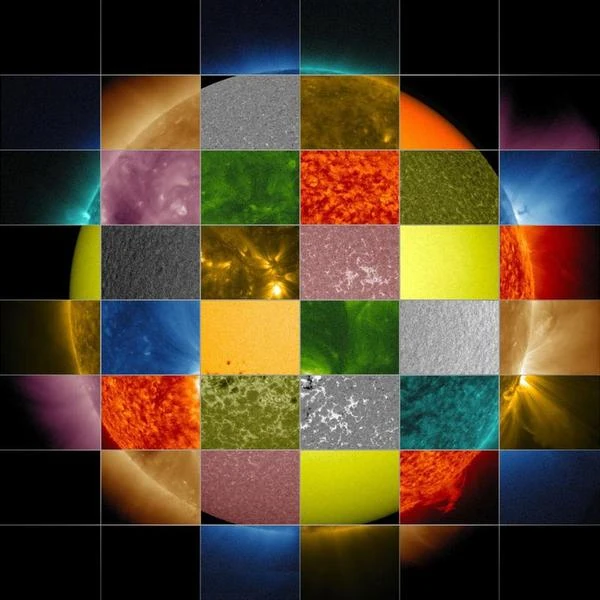
Image description: Composition of different aspects of the Sun's surface (atmosphere) in 10 different wavelengths (invisible to the naked eye). The observed object, here the Sun, appears in a beautiful "rainbow" of colors representing the Lights of the Sun. These particular lights are converted and colored by the SDO (Solar Dynamics Observatory) telescope. The higher the temperature, the more the dominant color shifts from microwaves to Gamma waves. Image source: NASA / SDO / Goddard Space Flight Center
The Sun emits a set of electromagnetic waves, from the far ultraviolet (FUV) like gamma rays (very high frequencies) to radio waves (very low frequencies), including X-rays, ultraviolet rays, visible light, infrared rays, and microwaves. These electromagnetic waves, whose vector is the photon, travel at a speed of ≈300,000 km/s.
With our eyes, we only see the wavelengths of the very small visible range located between 400 and 800 nm. For shorter or longer wavelengths, we need to use specialized equipment. The specialized instruments are generally ground-based or space-based telescopes equipped to observe light in different wavelengths.
The Sun sends us all the colors of light because it is filled with all the atoms present on Earth, each generating light at a certain wavelength depending on the temperature. In addition to the many different atoms (helium, hydrogen, carbon, oxygen, iron...), the Sun also contains different types of ions of each atom, with different electrical charges. Each ion can also emit light at specific wavelengths when it reaches a particular temperature.
Each observed wavelength reveals information about the different elements (atoms or ions) of the Sun's surface and atmosphere. By examining images of the Sun in a chosen variety of wavelengths, scientists can track the evolution of particles and temperatures present in the Sun's atmosphere.
This image of the Sun was constructed based on data from the SDO (Solar Dynamics Observatory) telescope of NASA. It shows a composition of different aspects of the Sun's surface or atmosphere in 10 different wavelengths chosen by scientists and invisible to the naked eye. These lights are converted into visible colors so that humans can see them. The observed object, here the Sun, thus appears in a beautiful patchwork of colors.
Since the 1900s, scientists have been cataloging the wavelengths absorbed or emitted by atoms and ions, as well as the associations between elements, wavelengths, temperatures, and colors. Telescopes make use of this precious wavelength information by embedding instruments like spectrometers that observe several wavelengths simultaneously and measure the quantity of elements present at each wavelength.
The scientists of SDO have chosen 10 particular wavelengths to observe the atmosphere and the movements of atoms in the solar layers. The wavelengths are expressed in angstroms (symbol Å) = 0.1 nanometers, or 10-10 meters, or one-tenth of a billionth of a meter.
Video description: Telescopes can collect light in frequency ranges inaccessible to our eyes. This beautiful film of the Sun, based on data from the Solar Dynamics Observatory of NASA, shows the wide range of wavelengths visible to the telescope's instruments. SDO converts the wavelengths into an image interpretable by the human eye. Each wavelength of light (each color) represents solar matter at specific temperatures. By examining the Sun in a variety of wavelengths, scientists can analyze the movements of particles as well as the temperature of the Sun's atmosphere. The images are generated by SDO but also by the imaging spectrographs of NASA, the NASA Solar Observatory on Earth, and the solar observatory and heliosphere of the European Space Agency.
| Visible color | Wavelength | |
| Red | ≈625 à 740 x 10-9 m | |
| Orange | ≈590 à 625 x 10-9 m | |
| Yellow | ≈565 à 590 x 10-9 m | |
| Green | ≈520 à 565 x 10-9 m | |
| Blue | ≈446 à 520 x 10-9 m | |
| Violet | ≈380 à 446 x 10-9 m |